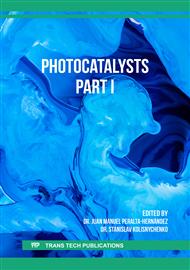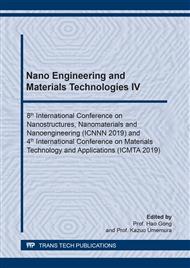p.225
p.231
p.239
p.244
p.250
p.256
p.262
p.267
p.272
Structure and Properties of Sputtered Ti-O-N Nanocomposite Films
Abstract:
Nitrogen-doped titanium oxide (Ti-O-N) thin films were deposited by reactive magnetron sputtering a titanium dioxide ceramic target in Ar/N2 plasma. By changing different flow rates of the nitrogen, various nitrogen concentrations and phases are formed in the films. With more nitrogen incorporated into the films, the absorption edge of the films exhibit a redshift which improve the visible light absorbance of the films. When the nitrogen flow rate was 20 sccm, a Ti-O-N nanocomposite film was formed containing 16.9 at% of nitrogen and phases of anatase TiO2, Ti3O5 and TiN, and the film possessed an absorbance in the visible light 3-4 times higher than that of pristine TiO2 thin film, but its photocatalytical performance was not enhanced accordingly. Only when a 50 nm thick layer of anatase was added to the Ti-O-N films forming a hetero-junction, the photocatalytic activity was then enhanced significantly. The photocatalytical properties of the films were affected not only by the film absorbance but also by the microstructure and the architecture of the films.
Info:
Periodical:
Pages:
250-255
Citation:
Online since:
May 2020
Authors:
Price:
Сopyright:
© 2020 Trans Tech Publications Ltd. All Rights Reserved
Share:
Citation:



